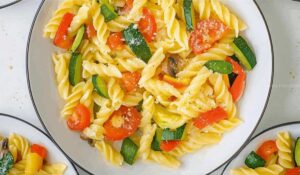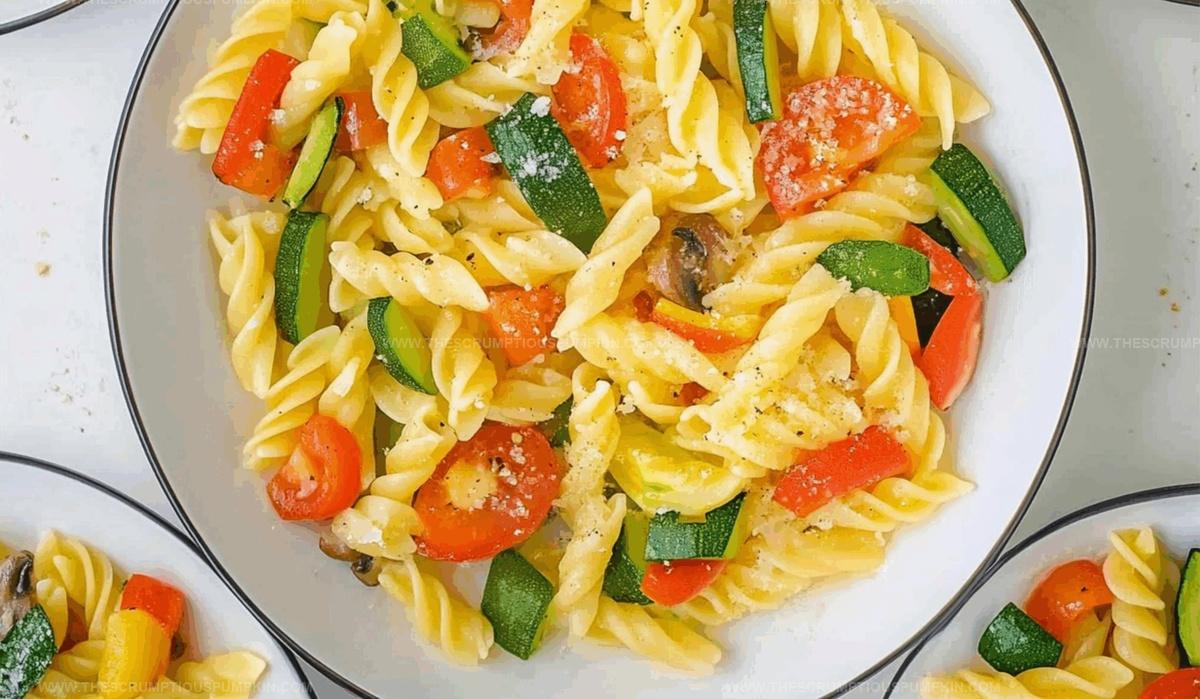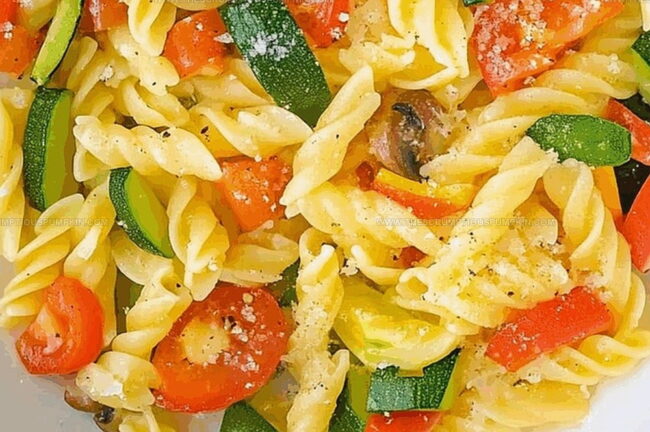Fresh Spring Pasta Primavera Recipe: A Colorful Italian Classic
Crisp spring vegetables dance delightfully through this pasta primavera, creating a vibrant symphony of fresh flavors.
Seasonal produce bursts with color and nutrition on every forkful.
Chefs adore this lightweight Italian-inspired dish for its simplicity and elegance.
Garden-fresh ingredients become the stars of this quick and delectable meal.
Vibrant zucchini, tender asparagus, and sweet bell peppers mingle seamlessly with perfectly cooked noodles.
Bright herbs and a light cream sauce elevate each bite into a culinary celebration.
You’ll want to savor every delicious morsel of this springtime classic.
Why Pasta Primavera Is Always in Season
Fresh Ingredients for Pasta Primavera Success
Main Ingredients:Vegetable Mixture:Flavor Enhancers:Steps to Cook Easy Pasta Primavera
Step 1: Boil Water for Pasta
Fill a large pot with water and add a generous pinch of salt. Crank the heat to high and bring the water to a vigorous boil that bubbles and dances.
Step 2: Prepare Colorful Vegetables
Grab your cutting board and knife. Chop these fresh ingredients into bite-sized pieces:Step 3: Sauté Aromatic Garlic
Warm olive oil in a large skillet over medium heat. Toss in minced garlic and cook until it turns golden and releases its irresistible fragrance.
Step 4: Cook Hearty Vegetables
Add carrots and broccoli to the skillet. Sauté for about 3 minutes, keeping them crisp and vibrant.
Step 5: Introduce More Vegetable Varieties
Toss in zucchini, yellow squash, and bell peppers. Continue cooking for 2-3 minutes, creating a rainbow of colors and textures.
Step 6: Cook Pasta to Perfection
Slide the pasta into the boiling water. Cook according to package instructions until it reaches that perfect al dente texture, typically 8-10 minutes.
Step 7: Create Creamy Vegetable Sauce
Pour heavy cream into the skillet, gently stirring to create a silky, luxurious sauce that hugs the vegetables.
Step 8: Combine Pasta and Vegetables
Drain the pasta, but save a splash of pasta water. Transfer the pasta back into the skillet with the colorful vegetable mixture.
Step 9: Season and Cheese It Up
Sprinkle parmesan cheese and your favorite seasonings over the pasta. Toss everything together to distribute flavors evenly.
Step 10: Add Fresh Finishing Touches
Gently fold in cherry tomatoes and fresh herbs. Be careful not to overcook these delicate ingredients.
Step 11: Adjust Sauce Consistency
If the sauce looks a bit dry, splash in some reserved pasta water to create the perfect creamy consistency.
Step 12: Serve and Enjoy
Plate your Pasta Primavera immediately. Top with extra fresh parsley and a sprinkle of parmesan cheese for that final gourmet touch.
Tips to Keep Pasta Primavera Fresh and Bright
Colorful Combos for Pasta Primavera Fans
Great Pairings for Pasta Primavera Meals
Storage Advice for Pasta Primavera Dishes
Common Questions About Pasta Primavera
Fresh, seasonal vegetables like zucchini, carrots, broccoli, bell peppers, and cherry tomatoes are perfect. Choose colorful, crisp vegetables that cook quickly and maintain their texture.
Absolutely. Replace heavy cream with plant-based alternatives like coconut milk or cashew cream. Substitute parmesan with nutritional yeast or vegan parmesan for similar flavor profiles.
Cut vegetables into uniform bite-sized pieces and sauté quickly over medium heat. Don’t overcook; aim for a crisp-tender texture by cooking vegetables for just 2-3 minutes.
Yes, it’s nutritionally balanced with vegetables, whole grains, and moderate protein.
Print
Pasta Primavera Recipe
- Total Time: 25 minutes
- Yield: 4 1x
Description
Fresh spring vegetables dance through homemade Pasta Primavera, creating a light symphony of seasonal flavors. Crisp garden produce and delicate herbs combine in this Italian-inspired dish that invites you to savor spring’s delightful culinary essence.
Ingredients
Pasta:
- 450 g / 1 lb pasta (penne or fettuccine)
Fresh Vegetables:
- 1 cup zucchini, chopped
- 1 cup yellow squash, chopped
- 1 cup bell peppers (mixed colors), diced
- 1 cup cherry tomatoes, halved
- 1/2 cup carrots, julienned
- 1/2 cup broccoli florets
Sauce and Seasonings:
- 1/2 cup heavy cream
- 1/4 cup olive oil
- 3 cloves garlic, minced
- 1/2 cup parmesan cheese, grated
- 2 tbsp fresh basil, chopped
- 1 tsp salt
- 1/2 tsp black pepper
- 2 tbsp fresh parsley, chopped
Instructions
- Prepare a large pot of salted water and bring to a rolling boil at high heat for pasta cooking.
- Simultaneously, chop all vegetables into uniform bite-sized pieces to ensure even cooking and attractive presentation.
- Heat olive oil in a large skillet over medium heat, adding minced garlic and sautéing until fragrant and lightly golden, approximately 1-2 minutes.
- Add julienned carrots and broccoli florets to the skillet, cooking for 3 minutes to slightly soften while maintaining crisp texture.
- Incorporate zucchini, yellow squash, and bell peppers into the skillet, continuing to sauté for an additional 2-3 minutes.
- Drop pasta into boiling water and cook according to package instructions until al dente, typically 8-10 minutes.
- Pour heavy cream into vegetable mixture, stirring gently to create a light, silky sauce coating the vegetables.
- Drain pasta, reserving 1/4 cup of pasta water, then return pasta to the skillet with vegetables.
- Sprinkle parmesan cheese and seasonings over the pasta, tossing thoroughly to distribute flavors evenly.
- Add cherry tomatoes and fresh herbs, gently mixing to prevent overcooking the delicate tomatoes.
- If sauce seems dry, incorporate reserved pasta water to achieve desired consistency.
- Serve immediately, garnishing with additional fresh parsley and parmesan cheese if desired.
Notes
- Chop vegetables uniformly to guarantee consistent cooking and enhance visual appeal for a restaurant-quality presentation.
- Maintain medium heat while sautéing to prevent burning garlic and vegetables, preserving their vibrant colors and crisp textures.
- Reserve pasta water as a secret weapon for creating silky, perfectly emulsified sauce that clings beautifully to noodles.
- Customize this recipe for dietary needs by substituting heavy cream with plant-based alternatives like cashew cream or coconut milk for vegan and dairy-free options.
- Prep Time: 10 minutes
- Cook Time: 15 minutes
- Category: Lunch, Dinner, Snacks
- Method: Boiling
- Cuisine: Italian
Nutrition
- Serving Size: 4
- Calories: 510
- Sugar: 4 g
- Sodium: 500 mg
- Fat: 30 g
- Saturated Fat: 10 g
- Unsaturated Fat: 20 g
- Trans Fat: 0 g
- Carbohydrates: 50 g
- Fiber: 4 g
- Protein: 12 g
- Cholesterol: 40 mg




Mia Thompson
Pastry Chef & Content Creator
Expertise
Education
Portland Community College – Baking and Pastry Arts Program
Specialized in artisanal bread, seasonal desserts, and sustainable baking methods.
National University of Natural Medicine – Bachelor of Science in Nutrition (BScN)
Focused on “Food as Medicine” philosophy, with core threads in nutrition.
Mia’s love affair with baking began in her grandmother’s kitchen, where sneaking spoonfuls of batter first sparked her curiosity. She refined her skills through Portland Community College’s Baking and Pastry Arts Program and her expertise at the National University of Natural Medicine, earning a B.Sc. in Nutrition.
At The Scrumptious Pumpkin, Mia reimagines classics with effortless seasonal treats, healthier twists on old favorites, and playful confections that feel like pure joy. Beyond the oven, she nurtures her urban garden, forages local ingredients around Portland, and leads hands‑on nutrition workshops for her community.